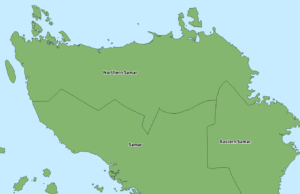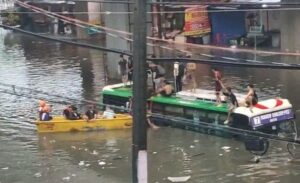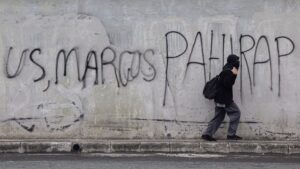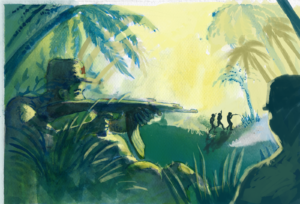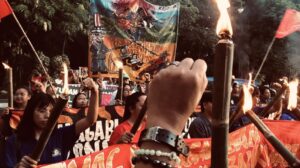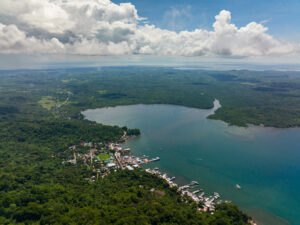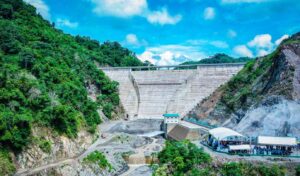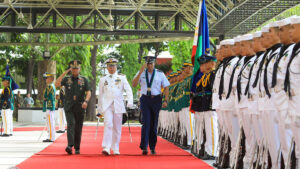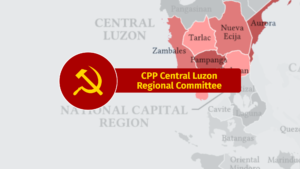The Filipino people’s revolutionary armed struggle for national and social liberation in the past 50 years
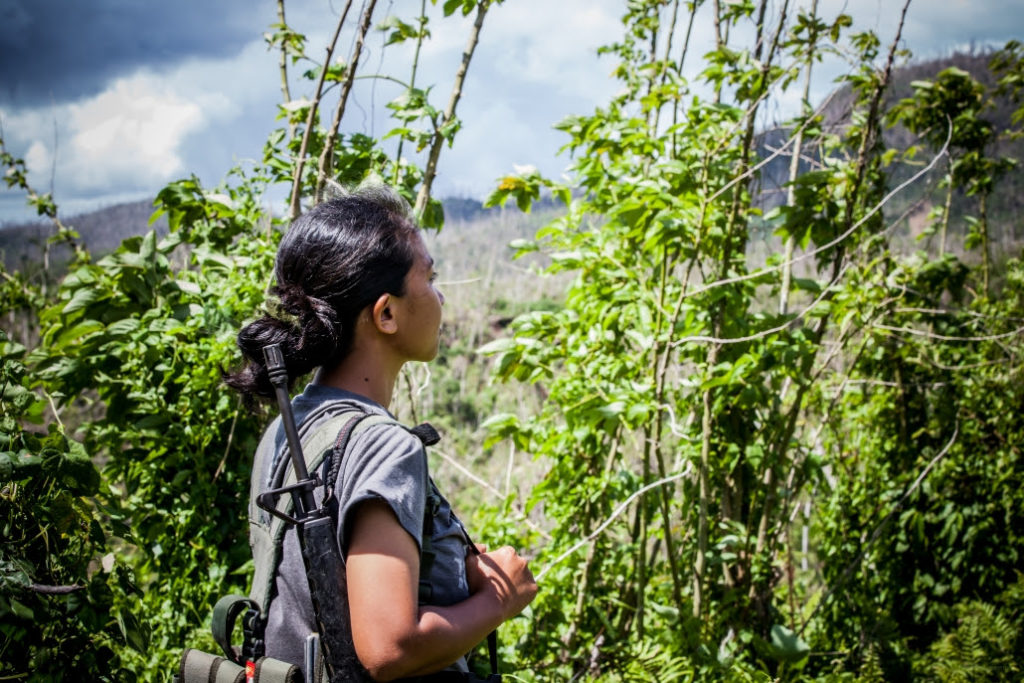
Let me do a quick review of the Filipino people’s revolutionary struggle for national and social liberation in the past 50 years. My focus is on the development of the New People’s Army (NPA) under the leadership of the Communist Party of the Philippines (CPP) in a brief historical narrative of five segments, including the prospects as the last segment.
1. Foundational Years, 1969 – 1977
The Central Committee of the Communist Party of the Philippines conceived of the New People’s Army as the main instrument for overthrowing the semicolonial and semifeudal ruling system through protracted people’s war in accordance with the people’s democratic revolution against US imperialism and the local exploiting classes of big compradors and landlords.
The New People’s Army was founded by the CPP in Barrio Sta. Rita, Capas, Tarlac on March 29, 1969. It started with only 9 rifles and 26 inferior firearms for 60 Red fighters consisting of those from the old people’s army and the new recruits from Manila and Isabela who were previously given politico-military training.
The recruits from Manila were CPP and Kabataang Makabayan members who came from various regions and were intended to form the NPA in their respective regions after serving in Tarlac. The recruits from Isabela were given priority for dispatch to their province for the purpose of CPP and NPA expansion. They were provided with a senior cadre who had long experience in armed struggle and mass work in Central Luzon.
The years 1969 to 1977 may be considered as the foundational years of the NPA. They were years of ideological study for those CPP cadres assigned to the NPA, political-military training for the Red commanders and fighters and deployment of expansion teams to various regions under the direction of the CPP Central Committee.
The NPA National Operational Command was formed under the Military Commission of the Party Central Committee. The following departments were slated to be formed: political education, planning, personnel and training, intelligence, military operations, production, logistics, ordnance and medical.
The Regional Operational Commands were also to be formed under the leadership of the Regional Party Committees. Provincial and district operational commands were also slated to be formed by the leading Party territorial committees concerned.
The NPA became trained and experienced in waging guerrilla warfare and doing mass work, which included mass education, mass organizing, land reform and production, health and sanitation, cultural work, people’s self-defense, arbitration and justice, disaster relief and protection of the environment.
From 1969 to 1971, the revolutionary armed struggle developed in Tarlac, combining guerrilla tactical offensives and mass work and bringing about the level of NPA armed strength to more than 200 automatic rifles that were seized from the enemy forces through ambushes and raids.
When the CPP central leadership shifted to Isabela from late 1970 to 1972, the NPA started with only 20 automatic rifles and these increased to more than 300 by 1974. Hundreds of CPP cadres were given politico-military training for expansion to new areas in various regions. These cadres were subsequently dispatched to provinces in Cagayan Valley, Ilocos-Montañosa-Pangasinan, Central Luzon, Southern Luzon, Visayas and Mindanao.
More expansion cadres became available after the 1971 suspension of the writ of habeas corpus and then the 1972 proclamation of martial law because the urban-based mass activists who were in danger of being arrested joined the NPA. Still a great number of underground cadres under the CPP General Secretariat were dispatched to various regions in 1974. The nationwide expansion of the CPP and NPA was facilitated by Kabataang Makabayan, trade unions and peasant associations.
As early as 1972, CPP regional committees and NPA regional operational commands were already established in Cagayan Valley, IMP, Central Luzon, Southern Luzon, Eastern Visayas, Central Visayas, Western Visayas and Mindanao. In subsequent years, NPA regional operational commands arose in Cagayan Valley, Cordillera and Ilocos, Southern Luzon, Western Visayas, Central Visayas and Eastern Visayas. And in 1976, the Mindanao regional Party Committee began to form several NPA regional operational commands.
In the foundational years from 1969 to 1977, the focus of the most frequent and most successful tactical offensives shifted from one region to another, depending on the successful mass work and the daring of the Red commanders and fighters. From 1969 to 1971, the focus was Tarlac; from 1972 to 1975, it was Isabela, Ifugao, Quirino, Aurora, Pampanga, Bataan, Quezon, Camarines Sur, Albay, Sorsogon, Negros and Panay provinces; and from 1975 to 1977, it was Samar and several provinces in Mindanao.
The NPA armed strength had reached the level of 1500 automatic rifles as of 1977. However the NPA in Isabela stagnated and weakened because of the error of staying too long in the unpopulated forest region from 1974 to 1976, despite the order of the central leadership to the regional Party committee in 1974 for shifting the NPA companies to Cagayan province. But the containment of the NPA in Isabela was countervailed by its growth elsewhere in Cagayan Valley, Northern Luzon and in the entire country.
2. Further Growth and Major Errors, 1978-1991
The strong foundation laid in the years 1969-77 and the preponderance of CPP and NPA rank and file who adhered to the theory and practice of Marxism-Leninism-Maoism, the general line of people’s democratic revolution and the organizational discipline of democratic centralism corresponded to the worsening socioeconomic and political crisis of the ruling system and made possible the further growth of the NPA to 3000 automatic rifles in 1981 and then to 5,600 automatic rifles in 1985.
The CPP central leadership ensured that whenever certain weaker regions needed support and assistance in terms or cadres and arms, they would get such from the stronger regions. After the NPA forces in Eastern Visayas grew strong from 1976 to 1979, the Party redeployed many of its cadres, fighters and arms to Negros and Mindanao in 1979. But the NPA in every region was always urged to practice self-reliance and grow through struggle.
The most outstanding regions in the frequency and success of tactical offensives from 1981 onward were Eastern Visayas, Mindanao, Negros, Northern Luzon, Bicol and Central Luzon. The most effective formations in combat were companies or platoons augmented by armed propaganda teams and led by commanders who were excellent at planning and were daring.
The NPA forces in the regions of Eastern Visayas, Bicol, Southern Tagalog and Cagayan Valley had a good balance of relatively concentrated force (vertical) and relatively dispersed forces (horizontal). This also meant a good balance between offensive capability and mass base. The Party, the mass organizations and the organs of political power assumed much of the work load of the NPA units to enable these to gain more time and opportunities for launching tactical offensives.
From 1981 to 1985, the NPA in Mindanao scored the most and biggest victories in tactical offensives as it increased the number of companies to five. But the further rapid formation of ten more companies and the premature verticalization of forces were done at the expense of paying attention to mass work and strengthening the mass base. The “Left” opportunist error resulted in adverse consequences.
The CC Plenum in 1985 noted that the nationwide NPA armed strength reached the level of 5,600 automatic rifles in 1985 and further increased to 6,100 automatic rifles in 1986 and still further increased by some hundreds in 1987. NPA nationwide armed strength increased because of the correct line, competence, courage and high sense of self-sacrifice and service to the people of the CPP cadres and members and the Red fighters and commanders and by the accelerated deterioration of social conditions and the rising tide of the people’s struggle against the Marcos fascist dictatorship.
The victories were achieved despite the emergence of wrong ideas and major errors in the CPP central leadership and in certain regional Party committees. In 1979 there arose the notion in the CC of the CPP that the people’s war was already in the advanced phase. This led to the further notion that the “stage of strategic counter-offensive” was in the offing.
This notion had no basis in reality and was not realized but encouraged various “Left”opportunist currents of thinking about short-cuts to final victory.
As early as 1981, the subjective notion circulated among certain CC members that the Marcos fascist dictatorship had succeeded in making the Philippines an industrial capitalist country. It gave rise to the Right opportunist and “Left” opportunist currents.
The Right opportunist current wanted to take out the leadership of the CPP and the working class from the National Democratic Front and make the legal form of struggle principal to the armed struggle in obeisance to the anti-Marcos reactionaries. The “Left” opportunist current was initially based on the wrong notion that the NPA had reached the “advanced stage” of the strategic defensive and could carry out next the strategic counteroffensive.
The most disastrous line was that of the “Left” opportunist Red Area- White Area (RAWA) line in Mindanao, which called for people’s strikes in urban areas, intensification of armed city partisan warfare and the premature regularization of the NPA and reduction to being a purely military force.
When the line resulted in setbacks, the “Left” opportunists generated panic, blamed “deep penetration” agents for the setbacks and punished suspected cadres and mass activists without due process through Kampanyang Ahos. As a result of the “Left” opportunist errors, the mass base shrank drastically by more than 50 per cent in Mindanao and the NPA armed strength fell by more than 1000 automatic rifles.
Similar “Left” opportunist errors followed by anti-DPA witch hunts occurred in other regions but on a lesser scale at various times in Negros island, Manila-Rizal, Southern Tagalog, Cordillera and Cagayan Valley. Most of the time NPA foundational strength and the preponderance of good cadres and members continued to prevail over the “Left” opportunism and over the emergence of anti-DPA hysteria.
The central level “Left” opportunists subsequently pursued the line from 1986 to 1989 that total victory could be obtained only with military assistance from abroad; otherwise the revolution would stagnate and then be defeated. When the efforts to import weapons failed, they became demoralized and were joined by the Right opportunists in opposing the strategic line of protracted people’s war.
3. Rectification and Revitalization, 1992-2001
The Second Great Rectification Movement (SGRM) from 1992 to 1998 saved the CPP, the NPA and the entire revolutionary movement from possible self-disintegration or destruction in the hands of the enemy. The Right and “Left” opportunists were in CPP key positions and were using these to undermine and attack Marxism-Leninism-Maoism and the general line of people’s democratic revolution.
The Right opportunists prated about “popular democracy” to attack the leading role of the proletariat and the CPP in the revolution. They blamed the line of protracted people’s war for the supposed failure to be part of the ascendance of the Aquino regime over the Marcos fascist dictatorship. They spouted Gorbachovite, Trotskyite, bourgeois-liberal and other petty-bourgeois currents of thinking.
The “Left” opportunists, especially the most vocal urban insurrectionists, also blamed the strategic line of protracted people’s war for the supposed failure of the NPA to take power or get a significant share of this before the Aquino party took complete power.
The “Left” opportunists in the highest positions babbled that to avert stagnation and defeat, the NPA must benefit from the importation of weapons, even if these were to be secured by considering the Soviet Union as no longer revisionist and social-imperialist. At the same time, they obscured the disastrous results of their line in Mindanao, which included the witch-hunt called Kampanyang Ahos.
Prior to the launch of the SGRM in 1992, the central leadership had already succeeded in acting against the “Left” opportunist errors and the anti-DPA witch-hunts in one region after another. But the SGRM still had to be launched and carried out in order to criticize, repudiate and rectify the errors comprehensively and thoroughly through a movement of ideological and political education. Otherwise, errors could persist to undermine and destroy the Party.
The SGRM faced difficulties because the “Left” and Right opportunists in general combined to attack the Party and take away the Party personnel and resources that they controlled. But the loyal Party cadres and members and the Red commanders and fighters prevailed. They worked hard and succeeded in recovering most of the Party personnel and mass base which had been lost through the errors, crimes and wrecking operations of the “Left” opportunists.
From 1994 to 1998, the forces in Mindanao were able to recover most of the armed strength and mass base that had been lost during the second half of the 1980s. They were able to retain some of the NPA companies in certain guerrilla fronts by a well-balanced correlation of relatively concentrated force for effectiveness in tactical offensives and relatively dispersed force to ensure a sufficiently wide and deep mass base. By 1998, the First Bagani Company had the distinct honor of capturing a brigadier general in the field.
The recovery and revitalization of the NPA occurred in various regions previously afflicted by “Left” opportunism. The NPA level of strength in 1998 exceeded the level before 1992, There were more than 110 guerrilla fronts nationwide, mostly with platoons rather than companies as the total force per front.
In the National Capital Region, the forces of the national democratic movement grew strong to the extent of generating mass protest actions that ultimately forced Estrada to flee the presidential palace and in effect resign his position. This was a crowning victory of the SGRM.
4. Growth, Conservatism and Upsurge, 2002 – 2019
This period covers the regimes of Arroyo, Aquino and Duterte which launched fierce attacks on the NPA and the entire revolutionary movement. The NPA has frustrated all the strategic operational plans aimed at destroying it. It has preserved and increased its strength despite the strategic offensives of the enemy, such as the Oplan Bantay Laya of Arroyo, Bayanihan of Aquino and Kapayapaan of Duterte.
As a result of the SGRM, NPA armed strength in high-powered rifles continued to grow and peaked in 2005 to a level surpassing the earlier 1987 peak by a few hundreds. It was a four percent growth from the 2002 level. However, from 2005, NPA strength dropped by 21.6 per cent over the course of the next four years until 2009.
The NPA armed strength in automatic rifles increased again but by only a few hundreds or around 11 per cent accumulated growth in the next seven years, 2009-2016 but remained below the 12.6 per cent below the 2006 peak. The NPA strength further grew by 9 per cent in the second half of 2016 but remained at 4 per cent below the 2005 peak From end 2016 to August 2017, the NPA grew more than 8 per cent and surpassed the previous 2005 peak by 3 per cent.
Despite the all-out war of the Duterte regime from its continuation of Aquino’s Bayanihan to its adoption of its own US-designed Oplan Kapayapaan, the NPA is growing in strength. The NPA in Mindanao remains the most outstanding in people’s war notwithstanding the prolonged imposition of martial law in the region and the wanton use of bombings and extrajudicial killings to suppress the armed revolution.
The CPP was able to hold its Second Congress successfully. It was able to identify the error of conservatism and over dispersal of small NPA units over a wide area as the principal error that has caused the stagnation and erosion of NPA and mass strength in Luzon and the Visayas. It is an error diametrically opposite the error of “Left” opportunism that had emerged in the years 1981-83 and grew in various regions until 1992.
The error starts with the good motivation of widening and deepening the mass base and developing all political prerequisites. And the erroneous tendency has been to over-disperse small units for mass work and neglect the main NPA task, which is to launch tactical offensives in order to seize weapons from the enemy and strengthen the NPA.
The force deployment with no relatively concentrated force for launching tactical offensives, and with the over-dispersal of small NPA units results in roving or floating units that are easy prey to the enemy and vulnerable to being put in purely defensive actions. When these small units are squashed by the enemy, the mass base that they have created eventually disappears, although available for recovery in the future. Conservatism amounts to abstinence from tactical offensives, which has played into the enemy campaign plans like those of Oplan Bantay Laya of the Arroyo regime, during which the NPA suffered a decrease in strength from 2005 onwards..
At first, the NPA in Mindanao had difficulties of countering enemy offensives under Oplan Bantay Laya and then Bayanihan. But eventually they were able to prevail against the enemy with the effective use of the basic tactics of guerrilla warfare and master the art and science of the tactics of counter encirclement against the enemy encirclements that were bigger but had wider gaps. The Red commanders and fighters had the wisdom to avail of a combination of mass base and rough terrain and the daring to launch tactical offensives against weak points of the enemy.
In the same way that they benefited from the experience and revolutionary cadres and commanders that came from Eastern Visayas in the 1980s, the CPP and NPA in Mindanao have been sharing the fruits of their victories with their comrades in Luzon and the Visayas their experience and battle-tested cadres and commanders by their redeployment to the regions of Luzon and the Visayas. Since 2017, they have been able to counter and prevail over the escalation of enemy attacks under the conditions of martial law.
A strong nationwide basis for the further advance of the people’s war has been established. It is now possible to launch more frequent and more daring tactical offensives on a national scale against the weak points of the enemy. These weak points are in far more areas than the enemy can reinforce and even where the enemy force is focused it exposes its weak points as soon as it is deployed.
Since the last quarter of 2017, there has been a significant increase of NPA tactical offensives on a nationwide scale than a long while before. After concentrating 75 per cent of their strength in Mindanao, the enemy armed forces have sent back more than 10 per cent of their strength to the Visayas and Luzon because of the intensified armed resistance here.
5. Prospects of the NPA
The current 5-year plan (2017-2021) of the Central Committee aims to carry forward the antifascist, antifeudal and anti-imperialist movement and overthrow the tyrannical US-Duterte regime, and bring the protracted people’s war to the advanced phase of the strategic defensive, in order to reach the threshold of the strategic stalemate.
The program calls for intensifying anti-fascist agitation, propaganda, organizational work and mobilization against the mass murders and other atrocities of state terrorism, and the scheme to establish a fascist dictatorship through charter change for a bogus kind of federalism. Building the broadest united front and mobilizing the people in their millions is the key to defeating the regime of terror and greed.
First, the program calls for resolving the imbalance of strength, spread and advance of guerrilla warfare between the relatively more advanced regions in Mindanao and those in Luzon and Visayas, and attain effective cooperation and coordination in advancing guerrilla warfare nationwide. The program seeks to develop 7-10 advanced regions, each with more or less 2,000 full-time Red fighters spread throughout Luzon, Visayas and Mindanao.
Secondly, it calls on the advanced regions to develop sub-regions with three to five interlocking company-sized guerrilla fronts, to serve as anchors and rallying points for inter-regional and national advance. The program estimates that we can effectively combat the sustained large-scale enemy operations in the advanced sub-regions with one or two full or undersized companies with nine to fifteen horizontal platoons in interlocking or adjacent guerrilla fronts, in addition to units of the people’s militias spread over several hundred villages.
Thirdly, the program aims to strengthen the NPA several times over and raise its capability in annihilating enemy teams and squads, and later, platoons. Every region and sub-region must have a company as vertical force following the ratio of one vertical company to every nine horizontal platoons (or 1:3). There must be recruitment campaigns to increase the NPA guerrilla units and people’s militia units and campaigns to generate material and other forms of support.
The NPA must be strengthened through ideological building, strengthening absolute Party leadership, systematic politico-military training and raising its combat capability, in terms of weaponry and technique, active political work to raise the political consciousness, the will to fight and offensive spirit of the Red fighters, strengthen their iron discipline and their close links with the masses.
It calls for building the NPA operational command at the national level down to the sub-regional level to develop planning, coordination and leadership of the NPA work. It also calls for the recruitment of cadres from workers and the educated youth and for developing, training and promotion of military cadres. It calls for further expansion and training of units of people’s militias, self-defense units of mass organizations to develop their capability in waging mass guerrilla warfare. It calls for building partisan units.
Fourthly, the program calls for intensifying guerrilla warfare nationwide and waging all-out resistance against the enemy’s all-out war, gradual constriction and win-hold-win and TRIAD campaigns. It calls for carrying out annihilative basic tactical offensives to deliver solid blows against the enemy, punish the worst fascist criminals, weaken the enemy, seize his weapons, strengthen the people’s army, advance the masses’ anti-feudal and other struggles and expand the democratic people’s power.
The program calls for firmly opposing military conservatism and repudiating the wrong ideas that bring about such weaknesses such as overestimating the strength of the enemy and underestimating the strength of the people and their army; fear of sacrifices and aspiring for comforts and failure to grasp the crucial necessity of intensifying guerrilla warfare in advancing other military and political tasks, locally and in general; lack of attention of leading Party committees on military work; overconfidence, passivity, over-dispersal of forces and so on. The program calls for maximizing NPA armed strength and its deep and wide mass support it enjoys in order to deliver bigger and more frequent blows against the enemy.
The program calls for strengthening vertical forces as the NPA leading force in mounting tactical offensives. Compared to horizontal forces, vertical forces are more concentrated in order for them to move quickly, by itself or together with horizontal units, when necessary to hit at the isolated and vulnerable enemy units. However, they should also make use of every opportunity to arouse, organize and mobilize the masses, help in waging mass campaigns and struggles, participate in production and conduct training, education and political work in between battles.
The horizontal or front guerrilla forces, on the other hand, ensure widespread and intensive guerrilla warfare by all-sidedly developing guerrilla fronts in the military, political, economic, organizational and cultural fields. At every given time, the optimum is for 60 per cent of the NPA units to engage in mass work and political work and 40 per cent to carry out tactical offensives.
The program clarifies that mass work in guerrilla fronts is armed propaganda-type, that is, military work, tactical offensives, combating enemy attacks and operations and raising the military capability of the army and the people. Local guerrilla forces serve as centers of gravity of people’s militia units and village self-defense units. There must be a principal front guerrilla unit to serve as anchor and rallying point of all combat maneuvers and resistance.
Mass work should result in building local Party branches and groups, section committees, mass organizations and organs of political power, in addition to people’s militia and self-defense forces. The capacity of local revolutionary forces must be raised to carry out their tasks on their own in order to unburden the local armed units with details of daily administrative work and allow them to concentrate on various aspects of military work.
The program calls for mounting well-planned tactical offensives with the aim of annihilating enemy units and seizing their weapons. The general guidelines and the tactics include the following: Concentrate a bigger force to mount surprise attacks against weaker, smaller and isolated enemy units. Combine numerous body blows with occasional head blows.
Develop inter-front, regional, inter-regional and national planning and coordination of campaigns and operations to boldly intensify guerrilla warfare by taking hold of the entire strength of the people’s army and carrying out direct and indirect coordination of various guerrilla forces. Raise the capacity for intelligence work at all levels. Carry out partisan operations in order to punish the enemy in the cities and in their main lines of communication and transportation.
The NPA has already spread nationwide and is deeply rooted among the toiling masses. It occupies most of the terrains favorable for guerrilla warfare. It takes full advantage of the strategic line of encircling the cities from the countryside as well as orchestrating tactical offensives in an archipelago according to the principle of centralized leadership and decentralized operations. The NPA is now in a position to deliver lethal blows to the enemy forces anywhere in the archipelago and thereby raise the level of its armed strength.
The Filipino people and all their revolutionary forces are confident that they will make great strides towards total victory in the revolutionary war for the people’s democratic revolution because they are gaining political and armed strength as the crisis of both the semicolonial and semifeudal ruling system and that of the world capitalist system are simultaneously worsening at an accelerated rate.
The inter-imperialist contradictions are sharpening and resulting in worse forms of exploitation and oppression, unprecedented crisis of global proportions, widespread state terrorism and wars of aggression. These are signals for the further rise and eventual victory of the people’s democratic revolution in the Philippines and the resurgence of the anti-imperialist movements and the world proletarian revolution.###

